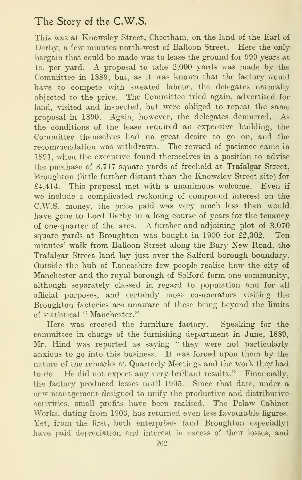Page 334 - The_story_of_the_C._W._S._The_jubilee_history_of_the_cooperative_wholesale_society,_limited._1863-1913_(IA_storyofcwsjubill00redf) (1)_Neat
P. 334
The Story of the C.W.S.
This was at Knowsley Street, Cheetham, on the land of the Earl of
Derby, a few minutes north-west of Balloon Street. Here the only
bargain that could be made was to lease the ground for 999 years at
Is. per yard. A proposal to take 2,000 yards was made by the
Committee in 1889, but, as it was known that the factory would
have to compete Avith sweated labour, the delegates naturally
objected to the price. The Committee tried again, advertised for
land, visited and inspected, but were obhged to repeat the same
proposal in 1890. Again, however, the delegates demxured. As
the conditions of the lease required an expensive building, the
Committee themselves had no great desire to go on, and the
recommendation was withdrawn. The reward of patience came in
1891, when the executive found themselves in a position to advise
the purchase of 8,717 square yards of freehold at Trafalgar Street,
Broughton (httle further distant than the Knowsley Street site) for
£4,414. This proposal met with a unanimous welcome. Even if
we include a compHcated reckoning of compound interest on the
C.W.S. money, the price paid was very much less than would
have gone to Lord Derby in a long course of years for the tenancy
of one-quarter of the area. A further and adjoining plot of 3,070
square yards at Broughton was bought in 1900 for £2,302. Ten
minutes' walk from Balloon Street along the Bury New Road, the
Trafalgar Street land lay just over the Salford borough boundary.
Outside the hub of Lancashire few people realise how the city of
Manchester and the royal borough of Salford form one community,
although separately classed in regard to population and for all
official purposes, and certainly most co-operators A-isiting the
Broughton factories are unaware of these being beyond the hmits
of statistical " Manchester."
Here was erected the furniture factory. Speaking for the
committee in charge of the furnishing department in June, 1889,
Mr. Hind was reported as saying " they were not particularly
anxious to go into this business. It was forced upon them by the
nature of the remarks at Quarterly Meetings and the work they had
to do. He did not expect any very briUiant results." Financially,
the factory produced losses until 1905. Since that date, under a
new management designed to unify the productive and distributive
activities, small profits have been reahsed. The Pelaw Cabinet
Works, dating from 1903, has returned even less favourable figures.
Yet, from the first, both enterprises (and Broughton especially)
have paid depreciation and interest in excess of their losses, and
262

